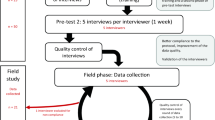Abstract
Purpose
In the original SF-6D valuation study, the analytical design inherited conventions that detrimentally affected its ability to predict values on a quality-adjusted life year (QALY) scale. Our objective is to estimate UK values for SF-6D states using the original data and multi-attribute utility (MAU) regression after addressing its limitations and to compare the revised SF-6D and EQ-5D value predictions.
Methods
Using the unaltered data (611 respondents, 3503 SG responses), the parameters of the original MAU model were re-estimated under three alternative error specifications, known as the instant, episodic, and angular random utility models. Value predictions on a QALY scale were compared to EQ-5D3L predictions using the 1996 Health Survey for England.
Results
Contrary to the original results, the revised SF-6D value predictions range below 0 QALYs (i.e., worse than death) and agree largely with EQ-5D predictions after adjusting for scale. Although a QALY is defined as a year in optimal health, the SF-6D sets a higher standard for optimal health than the EQ-5D-3L; therefore, it has larger units on a QALY scale by construction (20.9 % more).
Conclusions
Much of the debate in health valuation has focused on differences between preference elicitation tasks, sampling, and instruments. After correcting errant econometric practices and adjusting for differences in QALY scale between the EQ-5D and SF-6D values, the revised predictions demonstrate convergent validity, making them more suitable for UK economic evaluations compared to original estimates.


Similar content being viewed by others
References
Brazier, J., Usherwood, T., Harper, R.K.T.: Deriving a preference-based single index from the UK SF-36 health survey. J. Clin. Epidemiol. 51, 1115–1128 (1998)
EuroQol Group: EQ-5D products: EQ-5D-5L. http://www.euroqol.org/eq-5d/eq-5d-products.html. Accessed 7 Oct 2014
Torrance, G.W.: Social preferences for health states: an empirical evaluation of three measurement techniques. Socio Econ. Plan. Sci. 10, 129–136 (1976)
Torrance, G.W., Thomas, W.H., Sackett, D.L.: A utility maximization model for evaluation of health care programs. Health Serv. Res. 7(2), 118–133 (1972)
Tsuchiya, A., Ikeda, S., Ikegami, N., Nishimura, S., Sakai, I., Fukuda, T., Hamashima, C., Hisashige, A., Tamura, M.: Estimating an EQ-5D population value set: the case of Japan. Health Econ. 11(4), 341–353 (2002)
Brazier, J., Roberts, J., Deverill, M.: The estimation of a preference-based measure of health from the SF-36. J. Health Econ. 21(2), 271–292 (2002)
Lamers, L.M.: The transformation of utilities for health states worse than death: consequences for the estimation of EQ-5D value sets. Med. Care 45(3), 238–244 (2007)
Patrick, D.L., Starks, H.E., Cain, K.C., Uhlmann, R.F., Pearlman, R.A.: Measuring preferences for health states worse than death. Med. Decis. Mak. 14(1), 9–18 (1994)
Gudex, C.: Time trade-off user manual: props and self-completion methods. In: Report of the Centre for Health Economics. University of York, York (1994)
Williams, A.: A measurement and valuation of health: a chronicle. In: Discussion paper, vol. 136, pp. 1–53. Centre for Health Economics, York Health Economics Consortium, NHS Centre for Reviews & Dissemination, University of York, York, (1995)
Craig, B.M., Busschbach, J.J.: The episodic random utility model unifies time trade-off and discrete choice approaches in health state valuation. Popul. Health Metr. 7(1), 3 (2009)
Craig, B.M., Busschbach, J.J.: Toward a more universal approach in health valuation. Health Econ. 20(7), 864–875 (2011)
Craig, B.M., Oppe, M.: From a different angle: a novel approach to health valuation. Soc. Sci. Med. 70(2), 169–174 (2010)
Brazier, J., Roberts, J., Tsuchiya, A., Busschbach, J.: A comparison of the EQ-5D and SF-6D across seven patient groups. Health Econ. 13(9), 873–884 (2004)
Hatoum, H.T., Brazier, J.E., Akhras, K.S.: Comparison of the HUI3 with the SF-36 preference based SF-6D in a clinical trial setting. Value Health 7(5), 602–609 (2004)
Kharroubi, S.A., Brazier, J.E., Roberts, J., O’Hagan, A.: Modelling SF-6D health state preference data using a nonparametric Bayesian method. J. Health Econ. 26(3), 597–612 (2007)
Ware Jr, J.E., Gandek, B., Kosinski, M., Aaronson, N.K., Apolone, G., Brazier, J., Bullinger, M., Kaasa, S., Leplege, A., Prieto, L., Sullivan, M., Thunedborg, K.: The equivalence of SF-36 summary health scores estimated using standard and country-specific algorithms in 10 countries: results from the IQOLA Project. International quality of life assessment. J. Clin. Epidemiol. 51(11), 1167–1170 (1998)
StataCorp.: Stata Statistical Software: Release 10. In. StataCorp LP, College Station, Texas (2008)
Efron, B., Tibshirani, R.: An introduction to the bootstrap. Chapman & Hall, New York (1993)
Lin, L.I.: A concordance correlation coefficient to evaluate reproducibility. Biometrics 45(1), 255–268 (1989)
Craig, B.M., Brown, D.S., Reeve, B.B.: The value adults place on child health and functional status. Value Health J. Int. Soc. Pharmacoecon. Outcomes Res. 18(4), 449–456 (2015)
Craig, B.M., Pickard, A.S., Stolk, E., Brazier, J.E.: US valuation of the SF-6D. Med. Decis. Mak. 33(6), 793–803 (2013)
Craig, B.M., Reeve, B.B., Brown, P.M., Cella, D., Hays, R.D., Lipscomb, J., Simon Pickard, A., Revicki, D.A.: US valuation of health outcomes measured using the PROMIS-29. Value Health J. Int. Soc. Pharmacoecon. Outcomes Res. 17(8), 846–853 (2014)
Menzies, N.A., Salomon, J.A.: Non-monotonicity in the episodic random utility model. Health Econ. 20(12), 1523–1531 (2011)
Bansback, N., Brazier, J., Tsuchiya, A.: A comparison of using discrete choice experiments and the time trade-off to value health states for quality adjusted life years. Paper presented at the EuroQol Group Meeting, Paris, France, October 2009
Craig, B.M.: Arctangent model for conjoint analysis. Paper presented at the 2nd annual health econometrics workshop, University of Michigan, Ann Arbor, 1–2, Oct 2010
Donaldson, C., Baker, R., Mason, H., Jones-Lee, M., Lancsar, E., Wildman, J., Bateman, I., Loomes, G., Robinson, A., Sugden, R., Prades, J., Ryan, M., Shackley, P., Smith, R.: The social value of a QALY: raising the bar or barring the raise? BMC Health Serv. Res. 11(1), 8 (2011)
Lancsar, E., Wildman, J., Donaldson, C., Ryan, M., Baker, R.: Deriving distributional weights for QALYs through discrete choice experiments. J. Health Econ. 30(2), 466–478 (2011)
Baker, R., Bateman, I., Donaldson, C., Jones-Lee, M., Lancsar, E., Loomes, G., Mason, H., Odejar, M., Pinto Prades, J., Robinson, A., Ryan, M., Shackley, P., Smith, R., Sugden, R., Wildma, J.: t.S.R.: weighting and valuing quality-adjusted life-years using stated preference methods: preliminary results from the social value of a QALY project. Health Technol. Assess. 14(27), 162 (2010)
Whitehurst, D.G., Norman, R., Brazier, J.E., Viney, R.: Comparison of contemporaneous EQ-5D and SF-6D responses using scoring algorithms derived from similar valuation exercises. Value Health 17(5), 570–577 (2014)
Dolan, P.: Modeling valuations for EuroQol health states. Med. Care 35(11), 1095–1108 (1997)
Funding
Funding support for this research was provided by the National Institutes of Health (NIH) Infrastructure grant, “Developing Information Infrastructure Focused on Cancer Comparative Effectiveness Research” (RC2-CA148332; PI: Fenstermacher); and Dr. Craig’s National Cancer Institute (NCI) Career Development Award (K25 -CA122176).
Author information
Authors and Affiliations
Corresponding author
Ethics declarations
Conflict of interest
The author has no potential conflicts of interest.
Rights and permissions
About this article
Cite this article
Craig, B.M. Unchained melody: revisiting the estimation of SF-6D values. Eur J Health Econ 17, 865–873 (2016). https://doi.org/10.1007/s10198-015-0727-4
Received:
Accepted:
Published:
Issue Date:
DOI: https://doi.org/10.1007/s10198-015-0727-4




